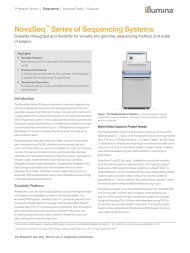Abstracts
ngsfinalprogram
ngsfinalprogram
Create successful ePaper yourself
Turn your PDF publications into a flip-book with our unique Google optimized e-Paper software.
Poster <strong>Abstracts</strong><br />
gonococcal infections in a culture independent<br />
manner. Ten AMR markers were examined,<br />
here and with the complete genome information<br />
provided by NGS there is the potential for<br />
many more to be investigated and for novel<br />
markers to be identified, highlighting the potential<br />
of this technology to enable continued<br />
AMR surveillance in areas where culture is no<br />
longer performed.<br />
n 76<br />
SUBTYPING OF E. COLI STEC BY<br />
TRADITIONAL LABORATORY METHODS AND<br />
WGS, A COMPARISON!<br />
E. Litrup, K. Kiil;<br />
Statens Serum Institut, Copenhagen, DEN-<br />
MARK.<br />
The traditional subtyping of E. coli STEC<br />
strains consists of many different and somewhat<br />
laborious and slow methods. In Denmark,<br />
we began whole genome sequencing of all E.<br />
coli STEC strains isolated from humans in<br />
January 2015. From January through June,<br />
we received and typed more than 70 STEC<br />
strains by both the traditional methods and<br />
WGS. The methods performed in our laboratory<br />
are serotyping, PCR assays and dot blot<br />
hybridization among others. Whole Genome<br />
Sequencing was performed in-house on an<br />
Illumina MiSeq with the Nextera Library<br />
Preparation kit and 250bp paired reads. For the<br />
comparison of WGS and traditional subtyping,<br />
we focused on the serotype, the stx1 and stx2<br />
subtypes and the presence of several genes<br />
e.g. the eae and ehxA gene. For detection of<br />
the serotype and virulence genes, we used the<br />
CGE finders (Serotype Finder and Virulence<br />
Finder https://cge.cbs.dtu.dk/services/), but<br />
we also used reference based mapping to the<br />
databases behind the finders with srst2 (https://<br />
github.com/katholt/srst2). The serotype was<br />
the subtyping method with the most divergent<br />
results as expected. The Serotype Finder was<br />
able to detect all but one serovar detected by<br />
the traditional serotyping. Additionally, almost<br />
all the strains typed as rough or smooth<br />
in the laboratory, were assigned an O-type<br />
by the Serotype Finder tool. Further, all the<br />
non-motile strains with no phenotypic H-type,<br />
were assigned an H-type by the Serotype<br />
Finder tool. Finally, there were some cross<br />
reactions between different sera in the laboratory,<br />
where the Serotype Finder was also able<br />
to give a result regarding which H type was<br />
more similar to the one sequenced. Regarding<br />
the detection of the stx1 and stx2 variants, eae<br />
and ehxA genes, we found an almost 100%<br />
correlation to the laboratory results achieved<br />
by PCR and dot blot hybridization. Only in a<br />
few cases did the laboratory achieve different<br />
results. We used the Virulence Finder on<br />
contigs assembled denovo by CLC and also we<br />
used reference based mapping to the databases<br />
behind the finder using SRST2, and we saw<br />
no differences in the performance of the two<br />
approaches. It is believed that reference based<br />
mapping is important for gene detection in E.<br />
coli as it can be challenging to assemble the<br />
reads into acceptable contigs, but in the case of<br />
these four genes and their variants this was not<br />
the case. This might be due to the location of<br />
these genes; they are probably located in parts<br />
of the genome that are easy to assemble.<br />
n 77<br />
DR. JEKYLL AND MR. HYDE: THE CASE<br />
FOR MIXED NOCARDIA POPULATIONS<br />
IN CLINICAL ISOLATES AS REVEALED BY<br />
WHOLE GENOME SEQUENCE ANALYSIS<br />
A. C. Lauer, B. Lasker, J. R. McQuiston;<br />
Centers for Disease Control and Prevention,<br />
Atlanta, GA.<br />
Nocardia species are aerobic GC-rich,<br />
partially-acid fast, opportunistic, pathogenic<br />
actinomycetes. Every year, approximately 200<br />
nocardiae isolates are received by the Special<br />
Bacteriology Reference Laboratory (SBRL) at<br />
CDC, however the true incidence of nocardiosis<br />
in the U.S. remains unknown. Despite reports<br />
of resistance to co-trimoxazole, the treatment<br />
of choice for nocardiosis, the molecular<br />
mechanisms of resistance in nocardiae are not<br />
ASM Conference on Rapid Next-Generation Sequencing and Bioinformatic<br />
Pipelines for Enhanced Molecular Epidemiologic Investigation of Pathogens<br />
91



